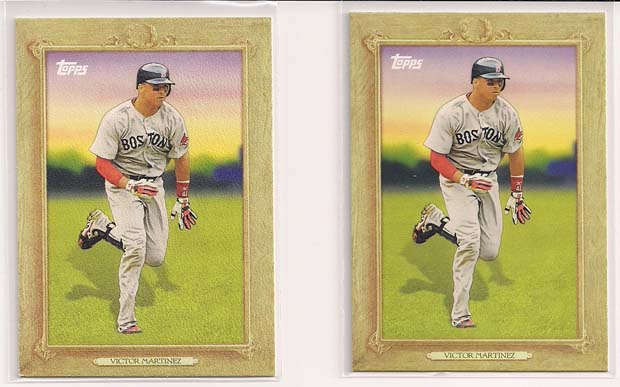A reader reached out to me and inquired about a 2010 Topps Turkey Red error he discovered in 2010 Topps Series 1
.

Here’s what he asked, and my response:
Mark Davis of whatsitworthappraisals.wordpress.com asks:
Hey Patrick, I ran across your website a couple of days ago. I like it. I have what I believe is an extremely rare manufacturing error from 2010 Topps Series 1. It’s a Turkey Red insert of Victor Martinez (TR30) printed on smooth paper stock. No texture or slight bend in the card like normal Turkey Red versions manufactured by Topps. I pulled the card from a Hobby Pack in early March 2010 right after the release of the product. I set it aside in a penny sleeve and tried to find out more about the error. Combed the internet for similar cards with the same error and found only one collector who found a smooth paper stock error of a Nolan Ryan Turkey Red insert card (2010 Topps Series 1). He posted a YouTube video of the Ryan card in the Spring of 2010. This is the only other info I could find about this manufacturing error. I called Topps and they could not confirm the error but said, You have something there.? I believe this could truly be one of the most rare manufacturing errors on record. My guess is very early in the 2010 print run the incorrect paper stock (possibly only 1 sheet) was used. It made it through the printing and packaging process and was shipped in some of the very first product produced. Do you have any knowledge of this particular error?
-Mark Davis
Hi Mark,
I’m glad you reached out to me about this particular error because, while I haven’t seen it on the Turkey Red set, I have for some other releases. Bear with me here, as we’ve got a lot to cover. I’ll first discuss manufacturing defects, and then I’ll talk about market value.
Manufacturing Defects
In manufacturing, there’s a strategy called, Six Sigma; you may be familiar with this concept as I’ve touched on it before.1 Six Sigma is a quality process improvement strategy that aims to minimize defects in the production process. It’s name is derived from how many deviations away from the mean quality output can be found. Six deviations equates to a quality output of 99.99% (0.01% scrap).
This is ultimately critical in manufacturing because higher levels of quality output equates to lower levels of waste, which ultimately means more dollars saved.
So why am I talking about Six Sigma? Well, because it’s only a benchmark. In manufacturing, some degree, some percentage of defects is at least expected even though always strongly discouraged. Thing is, nothing’s perfect, but we can at least aim for perfection.
So, with large amounts of units produced, say with something like baseball cards, we’re talking about production schedules in the millions, depending on the product. While I can’t say with any degree of certainty how much 2010 Topps Turkey Red was produced, I would at least feel partially confident in assuming production numbers in the upper hundreds of thousands, maybe more. That said, the likelyhood of some amount of scrap is at least partially promising.
I’ve seen all kinds of random manufacturing defects produced from the presses in baseball card manufacturing plants. Some include: blank/wrong front/back; wrong name; overprint; wrong sport depicted; miscuts; missing foil/photo/text; no gloss/foil/color; and I’ve seen versions just like what you have there, wrong paper format. With the volume of output that gets produced, it’s almost a guarantee that mistakes will be made along the way. While unintentional, it just happens.
Value
Your 2010 Topps Turkey Red probably card came from that 0.01% of scrap. Are cards from this 0.01% rare? Yea, if you think of it in the totality of production output. Might be a 1/1, might not. There’s no way to know, unless you find another 2010 Turkey Red Victor Martinez card with the same issue. Keep in mind, however, that just because something is rare it doesn’t always mean that it’s valuable.
Are these cards valuable? Well, that all depends on who has them in their possession. From the manufactures perspective, all scrap is considered waste, or trash, so there is no value associated with these cards from the perspective of the manufacture. The definition of perceived value may differ from the perspective of the collector. Keep in mind however, the difference between perceived value and actual value. Perceived value is the value the owner assigns to the product, while actual value is that which the market is actually willing to pay for the product. While those two numbers can be the same, they often aren’t.
Value is also attributed to the player depicted on the card. In terms of target market for your Victor Martinez card, there are at least three distinguishable markets:
- Collectors who live in Detroit
- Collectors of Victor Martinez
- Collectors of manufacturing defects
Best way to gauge actual market value is always eBay. Start the bidding off at $0.99 and just let the market make the decision on value. End price is actual value.
To shop for cards from 2010 Topps Turkey Red, click here.
References:
- Six Sigma. www.investopedia.com ↩︎

 Have you visited our store? Click here.
Have you visited our store? Click here.


